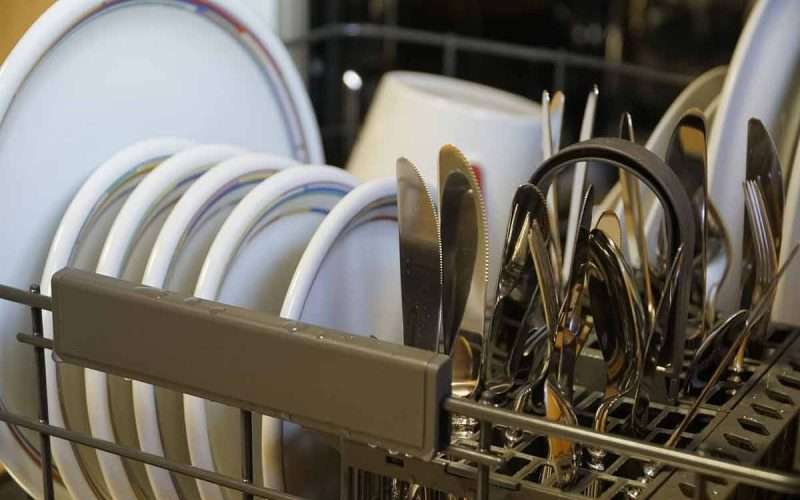Table of Contents Show
What is a Dishwasher?
A dishwasher is an appliance often used in kitchens for automatic dishwashing. The machine runs on electricity and water in the house. It soaps and rinses the dishes, just like a robot is working!
You can easily think of a washing machine when trying to understand working of a dishwasher.
As a rule, you put the dirty dishes in the dishwasher, then add the dishwasher detergent, and the process starts. There is a whole process with many steps that are preset inside the dishwasher through which it cleans the dirty dishes followed by a rinse cycle.
How does a Dishwasher work?
A dishwater is a machine, hence, there are some functions that it needs to perform to get the work done. And the work majorly is to get the clean dishes out. Here are the steps that it goes through after you load the dirty dishes into it:
- Firstly, it adds water itself.
- Then the water is heated up to an appropriate temperature.
- After that, it opens the detergent section, and the detergent slides to the dirty dishes.
- Then the water shoots through a spray arm and cleans the dishes.
- Then, the dirty water drains out, and the machine sprays another round of water to rinse the dishes.
- After the water drains again, the dishwasher heats the air so that the dishes can dry off.
So, this is a typical working of a dishwasher that most people use. Additionally, most dishwashers monitor themselves to ensure that the process is proper. There is a sensor inside the machine that regulates the water and air temperature inside the dishwasher.
Further, it has to detect and control the temperatures to prevent any damage to the dishes caused by overheating. The second sensor present in the machine ensures that the water level does not get high and prevents overflowing.
Main Parts of a Dishwasher

1. Control Mechanism
A control mechanism sits inside the dishwasher beside the control panel. Many dishwashers work on a simple electro-mechanical system that consists of a timer. The timer tells us the duration of each process. It also ensures that each stage is accurate to the minute.
Some expensive dishwasher units have an option for an advanced computerized control system. These advanced units have a modern design. They have a latch that should be properly closed before the machine operates.
2. Water Intake valve
A water intake valve is the part from where the water enters the dishwasher through the house’s water supply. Placed inside the dishwasher, it allows a specific amount of water during the washing process.
As the valve opens, the water pressure pushes the water inside the unit and cleans the dishes. After that, the dirty water drains away.
3. Circulation Pump
Another part of a dishwasher, powered by an electric motor, is called the circulation pump. During washing, the circulation pump pressurizes the water into the arms of the spray. And during the draining process, the pump regulates the water and ensures that wastewater makes its way out through the drain hose.
This circulation pump is fixed beneath the dishwasher basin at the center. The two main types of circulation pumps are:
- Reversible: A reversible pump can switch between pumping water to the spray arms and pushing water to the drain hose. It does this by reversing the direction of the motor. Usually, reversible pumps have a vertical axis.
- Direct-drive: In a direct-drive pump, the motor can run in a single direction. So, the direction is either towards the water flow or the spray arms of the dishwasher drain pipe. A solenoid valve controls the flow. Direct-drive pumps have a horizontal axis.
Are Dishwashers Environment Friendly?
1. Dishwashers are More Efficient than Hand Washing
According to many researchers, dishwashers use half the energy, one-sixth of water, and lesser soap than washing dishes by hand. Even if you be very careful about not wasting the resources, you might still end up wasting them.
Plus, according to popular wisdom, dishwashers excel in cleaning the dishes more than they can ever be washed by hand.
Furthermore, most of the dishwashers that are made since 1994 consume up to 10 gallons of water per the washing process. Whereas, the models made before 1994 used up to 15 gallons. This proves that advanced manufacturing has surely increased the efficiency of the product.
In the dishwasher, the water gets heated up automatically and the house heater does not have to work hard to regulate the water temperature. Water is only heated as and when it is needed in the appliance.
A standard size of a dishwasher is 24 inches wide and it consists of 8 place settings. Modern dishwashers now come in size of 18 inches, hence, use less water.
Buying an energy-efficient dishwasher will help save the environment. If you wish to buy an energy-efficient dishwasher, just make sure that there is an ‘energy star’ rating on it.
Dishwasher appliances that have this label on them are a sign that they are tested in terms of saving energy. While being of the best quality, they also ensure that the appliance does not harm the environment in any way.
2. Advanced Dishwashers Help Save Money
The U.S. Environmental Protection Agency (EPA) issues an energy star label to the new and advanced dishwashers that can meet energy and water-saving efficiency standards. Along with being efficient and getting the work done properly, the advanced dishwashers save money as well.
An average household saves energy costs of about $25 per year. The EPA recommends using the dishwasher when it is fully loaded with dishes. This will avoid the inefficient heat-dry, rinse-hold, and pre-rinse features found in an advanced and modern dishwasher.
The appliance uses energy and most of the energy is consumed by heating water. If the dishwasher is not full of water while it is operational, that will just waste energy.
Using an ‘energy star’ labeled dishwasher can save you $40 a year. Along with saving money, your time and energy will also be saved and you can call yourself eco-friendly too. According to some reports, using an Energy star rated dishwasher will help you save 5000 gallons of water a year than washing the dishes by hand.
You will be able to save a lot of time, by as much as 230 hours that are gone when hand washing the dishes. Dishwashers are quite beneficial after all!
3. Dishwashers have a Low Carbon Footprint
Recent studies have found that hand-washing the dishes has a higher carbon footprint than a dishwasher. Even though many people are very careful while using hot water when doing the dishes when the tap is left running with hot water, the carbon footprint increases.
However, you have to ensure that the dishwasher is only operated when it is fully loaded. If you are someone who operates the dishwasher many times a day then obviously the carbon footprint of your dishwasher will be higher.
The carbon footprint of an appliance is nearly impossible to accurately note down. An average is about 130g of carbon dioxide per wash cycle for a modern and advanced dishwasher. The more efficient your dishwasher is, the lesser the carbon footprint generated.
Thus you can save time, have economic benefits, and lessen your carbon footprint if you choose the latest version.







